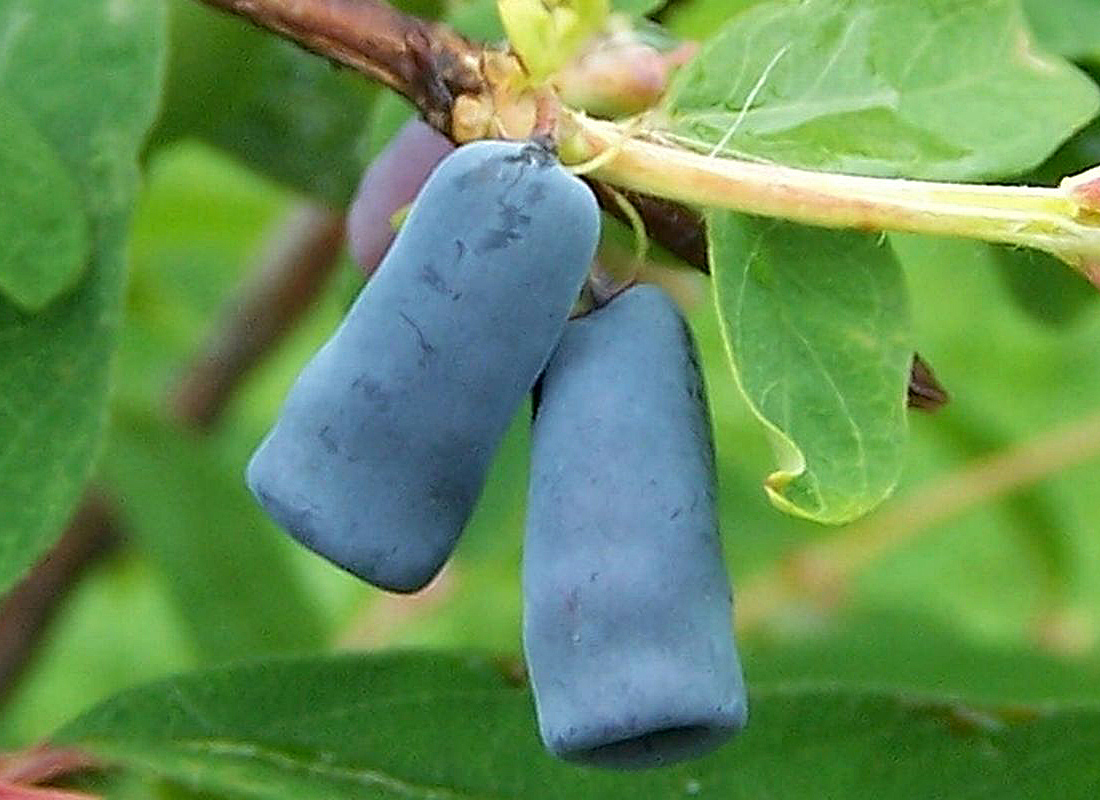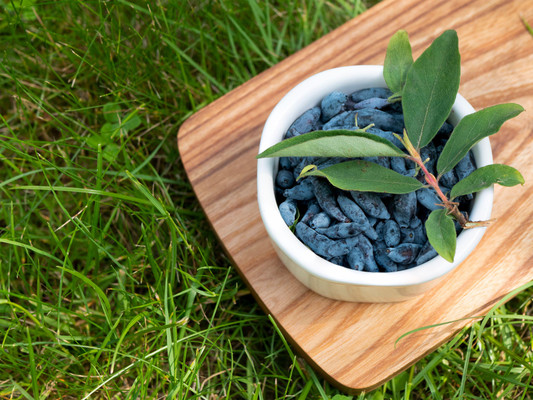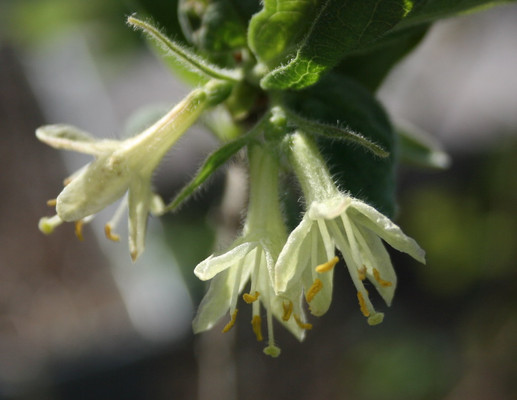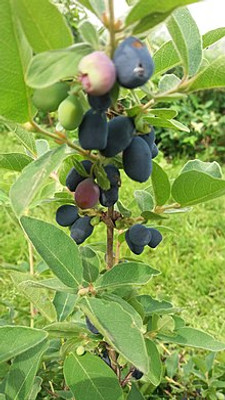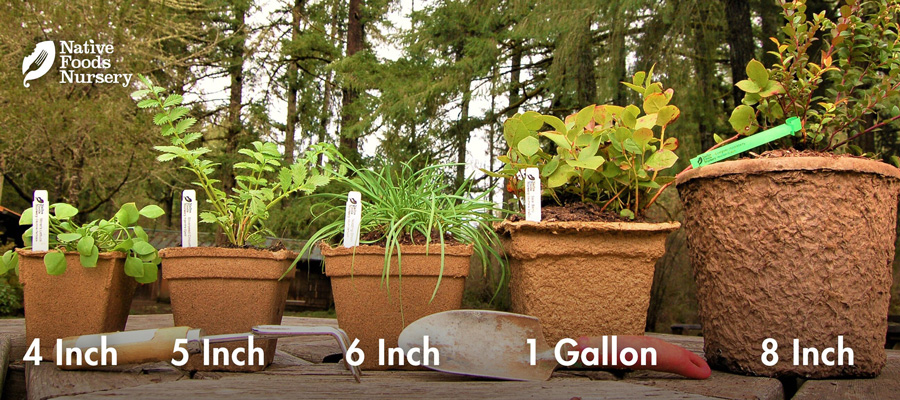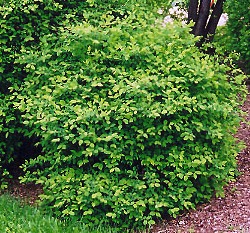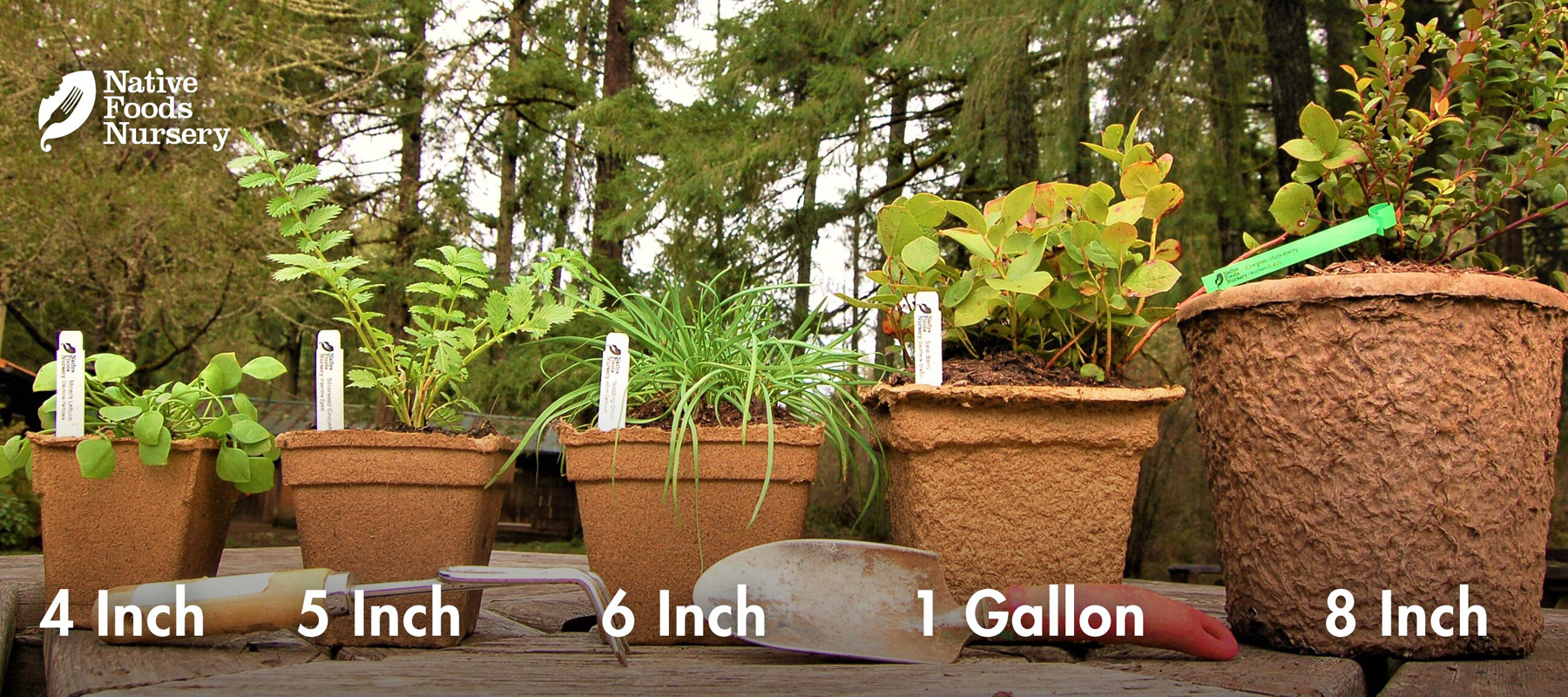Honeyberry - Beauty-Beast-Blizzard
- Current Stock:
- 0
- Other Names:
- Haskap, Blue Honeysuckle, Sweetberry Honeysuckle, Fly Honeysuckle, Blue-berried Honeysuckle
- Latin Name:
- Lonicera caerulea
Honeyberries (haskaps) are rugged, cold-hardy shrubs that deliver the season’s first deep-blue harvest—sweet-tart, nutrient-dense, and wildly versatile.
Our three specialty varieties are among the sweetest and largest available and set fruit in succession through the summer: “Beauty”, “Beast,” and a new third—"Blizzard". See a side by side variety comparison table at the bottom of the page! NOTE: At least two varieties are required for cross pollination and need a minimum of ~1,000 chill hours.
Edible Uses
Honeyberries are similar in color and taste to blueberries, with a tart-sweet balance and hints of raspberry or elderberry [1][2]. They can be used fresh or processed into pastries, jams, juices, sauces, ice creams, yogurts, candies, and even wine [3].
Nutritionally, honeyberries are a powerhouse: they contain high amounts of vitamin C (ascorbic acid), polyphenolic flavonoids, and anthocyanin antioxidants—often higher than in blueberries [2][4]. These compounds support immune health, circulation, and cellular protection.
Ornamental Qualities
Honeyberries are attractive, long-lived shrubs with oval green leaves and clusters of small, trumpet-shaped white flowers [1][5]. Flowers attract bees, butterflies, and hummingbirds, followed by elongated blue berries. In winter, bare branches often show a reddish tinge.
Honeyberries are ideal for edible landscapes—they can live and bear fruit for 50+ years under good care [2]. Plant them alongside huckleberries, thimbleberries, or currants for a productive and diverse food forest planting.
Environment and Culture
Honeyberry (Lonicera caerulea) is circumpolar in range, native to boreal forests of North America, Russia, and Japan [1]. Wild plants are often found in moist, organic soils of peat bogs, river valleys, and mountain terrain [6]. They thrive in cold climates and are famously hardy to about –47 °C (–53 °F) [2].
The Boreal trio—‘Beauty’, ‘Beast’, and ‘Blizzard’—draws on mixed Japanese, Russian, and Kurile genetics and have been selected for flavor, berry size, cold-hardiness, and pollination compatibility. Varieties with native North American genetics are not yet available (due to smaller fruit size in initial breeding trials), but we will offer them when they are!
Indigenous communities across the Northwest continue to harvest and tend native berry landscapes as living food and medicine. Honoring this stewardship—and supporting Indigenous-led restoration—helps sustain both people and place [7].
Harvest, Care, and Preparation
The trio staggers ripening—‘Blizzard’ earliest (early June), ‘Beast’ mid-season (late June–July), and ‘Beauty’ latest (late July into early August) [2]. For pollination, ‘Beast’ is the ideal bridge, starting when ‘Blizzard’ starts and ending when ‘Beauty’ ends, so planting ‘Beauty’ + ‘Beast’ + ‘Blizzard’ ensures reliable overlap and stretches the harvest from early to late. For balanced yields, use roughly one ‘Beast’ for every 2–3 ‘Beauties’, and include ‘Blizzard’ anywhere your spring runs cool so its earlier bloom still meets ‘Beauty.’
Honeyberries are less finicky than blueberries, tolerating a wider soil range, though they perform best in well-drained soils rich in organic matter [1]. Protect young plants from hot southern sun exposure, especially in warmer zones.
-
Watering: Regular irrigation during establishment (1–2 years) is essential; summer watering increases yields.
-
Mulching & Pruning: Annual mulching with organic matter and periodic thinning keeps shrubs healthy and productive.
-
Birds: Birds love the fruit—netting may be necessary to secure your harvest.
Harvest berries when fully blue and slightly soft. Use fresh, or freeze, dry, or preserve them. Their unique flavor makes exceptional jams, syrups, wines, and desserts.
Attributes
Native Range: Circumboreal (northern North America & Eurasia — Alaska/Canada, Russia/Siberia, Japan)
USDA Zones: 2–7 (up to 8 in cool-summer/coastal sites)
Ease of Care: Easy
Deer Resistance: Moderate (some browsing possible)
Light Requirements: Full sun to part shade
Soil Type: Well-drained, organic-rich; slightly acidic to neutral (approx. pH 5.0–7.0)
Water Requirements: Even moisture; water during establishment (1–2 years); best fruit with steady summer water
Pollination: Requires two different varieties with overlapping bloom; plant at least one ‘Beast’ with ‘Beauty’ (add ‘Blizzard’ to extend overlap)
Bearing Age: 1–2 years
Size at Maturity: 4–6 ft
Plant Spacing: ~6 ft (4–5 ft for a tight hedge)
Bloom Time: March–April (late March in Zone 8)
Harvest Time: June–July (varies by climate and variety; ‘Beauty’ tends later)
Variety Comparison Table - Beauty, Beast, Blizzard
| Attribute | Boreal Beauty | Boreal Beast | Boreal Blizzard |
|---|---|---|---|
| Bloom & pollination | Latest of the trio; overlaps with Beast. Also compatible with Blizzard (and often Aurora), though those may stop a few days earlier[3][4]. | Bridges the window—starts with Blizzard and ends with Beauty; compatible with both (and Aurora)[1]. | Earliest of the trio; overlaps with Beast; in cool springs may finish before Beauty[2][4]. |
| Best partner(s) | Beast (best), Blizzard (good)[1][3]. | Beauty and Blizzard[1][2]. | Beast (best); Beauty often overlaps enough[2][4]. |
| Ripening window (Saskatoon reference) | Late July–early Aug (latest; ~1 month after most varieties)[3][5]. | Mid–late July (before Beauty)[1]. | Early–mid July (earliest; “first 3 weeks of July” in 2014)[2]. |
| Fruit size (avg; max) | ~2.6 g avg; up to ~3.7 g; thick/oval; firm/meaty[3]. | ~2.0 g avg (1.86–2.06 g reported)[1]. | ~2.8 g avg; up to ~3.9 g; very large[2]. |
| Flavor & texture | Rated “excellent”; firm/meaty; holds well on branches[3]. | Rated “excellent”; notable aroma/aftertaste; very firm[1]. | Rated “excellent”; juicy with sweet-tart “zing”; good firmness[2]. |
| Plant habit & vigor | Upright, very strong/sturdy; bred for mechanical harvest[3]. | Upright, very vigorous; sturdy branching (Kurile ancestry)[1]. | Upright, strong grower; heavy productivity[2]. |
| Harvest style | Latest picking; uniform, firm berries suit fresh + processing[3]. | Bridges the window; can hold on bush; good for combined picks[1]. | Earliest picking; standout size speeds U-pick/fresh market[2]. |
References
[1] Bors, B. “Growing Haskap in Canada.” University of Saskatchewan, 2015.
[2] Thompson, M. “Introduction to Haskap.” Oregon State University Extension, 2017.
[3] Plekhanova, M. N. “Blue Honeysuckle (Lonicera caerulea L.) – A New Commercial Berry Crop.” Acta Horticulturae, 2000.
[4] Jurikova, T. et al. “Nutritional and Biological Value of Haskap Berries (Lonicera caerulea L.): A Review.” Journal of Functional Foods, 2012.
[5] Dirr, M. A. Manual of Woody Landscape Plants. Stipes Publishing, 2009.
[6] USDA NRCS. Plant Guide: Lonicera caerulea. plants.usda.gov.
[7] Turner, N. J. Food Plants of Coastal First Peoples. UBC Press, 1995.
Pot Sizing Guide
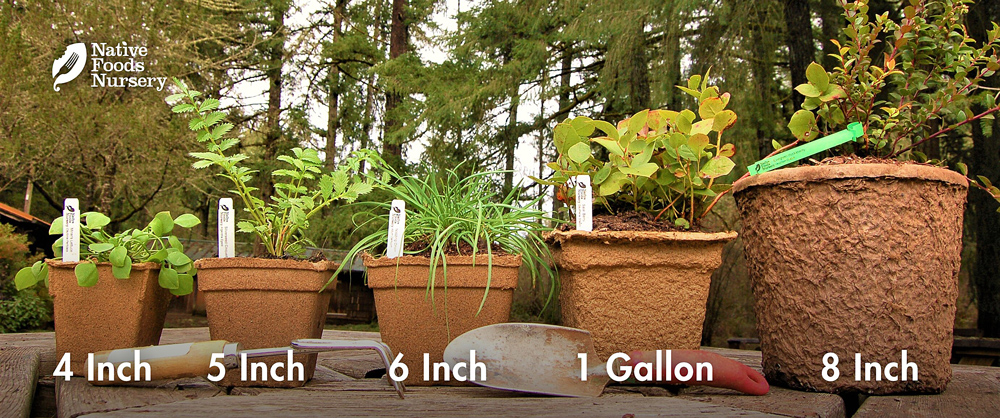
Planting Guide: Honeyberry (Lonicera caerulea)
Tip: Honeyberries thrive when mimicking their cool, moist northern forest origins — give them rich soil, steady moisture, and a pollination partner, and they’ll reward you with fruit for decades.
Choosing a Site
- Light: Full sun to part shade; protect from intense southern exposure in hot climates.
- Soil: Prefers well-drained, organic soils. Neutral to slightly acidic pH is best.
- Space: Plant ~6 ft apart; shrubs reach 4–6 ft tall and wide.
- Pollination: Requires two different varieties for fruit set. Plant at least one “Beauty” and one “Beast.”
Planting Steps
- Plant in early spring or fall while dormant.
- Dig a hole twice as wide as the root ball.
- Amend soil with compost or well-decomposed organic matter.
- Place the plant at the same depth as in its container. Backfill gently.
- Mulch with 2–4 inches of bark, leaves, or straw to conserve moisture and protect shallow roots.
- Water thoroughly after planting.
Watering & Care
- Establishment: Keep soil evenly moist during the first 1–2 years.
- After establishment: Drought tolerant in cool climates but fruits best with consistent summer watering.
- Summer Heat: Provide afternoon shade or light protection in warmer zones.
- Mulch yearly with organic matter to feed soil and conserve moisture.
- Pruning: Thin every few years to maintain airflow and rejuvenate stems.
Protection
- Wildlife: Birds love ripe berries — netting may be needed to save your crop.
- Deer: Moderately resistant, though new growth may be browsed.
- Pests: Mites and mildew are common issues (see detailed advice for organic controls at bottom)
- Companions: Plant alongside other berry shrubs (currants, huckleberries, thimbleberries) for a diverse edible landscape.
Harvest Basics
- Timeline: Begin bearing in 1–2 years.
- Season: June–July, depending on climate and variety.
- Use: Eat fresh, or preserve in jams, syrups, wines, and desserts. Berries also freeze well for long-term storage.
Note: For reliable fruit set, pair Beauty with Beast as pollination partners.
Organic Pest & Disease Management
Powdery Mildew
Prevention & Cultural Care:
- Airflow & spacing: Plant with adequate spacing and prune to open the canopy; avoid overhead watering to reduce leaf wetness and humidity.
- Resistant cultivars: Select mildew-tolerant varieties when possible (e.g. ‘Tundra’ shows higher resistance in trials).
- Sanitation: Remove and compost or destroy heavily infected leaves at season’s end to reduce overwintering spores.
- Morning rinses: Spraying foliage with plain water early in the day can help knock spores off and reduce spread.
Organic Inputs:
- Elemental sulfur: Effective preventive spray; apply in cool weather only (avoid above ~26–30 °C to prevent leaf burn).
- Potassium bicarbonate: A contact fungicide that disrupts mildew spores on contact; often used with a light horticultural oil for better coverage.
- Biologicals: Products containing Bacillus subtilis or Trichoderma spp. are OMRI-listed and can help suppress mildew when rotated in.
Mites (esp. eriophyid mites)
Prevention & Cultural Care:
- Water sprays: A firm jet of water can dislodge mites from foliage without chemicals.
- Sanitation: Remove infested leaves at the end of the season; clean up debris and weeds under plants that may host mites.
- Encourage predators: Avoid broad-spectrum insecticides that harm beneficial mites and insects; maintain plant diversity to support natural enemies.
Organic Inputs:
- Horticultural oils (dormant & summer weight): Delayed-dormant oil sprays in early spring can suppress overwintering mite populations; lighter summer oils can help manage outbreaks. Always test on a few leaves first.
- Insecticidal soaps: Contact sprays (fatty acid salts) that are OMRI-listed can reduce mite populations when coverage is thorough.
Note: Many mite issues on haskap are cosmetic. Treat only if populations are high or plant vigor is threatened.
